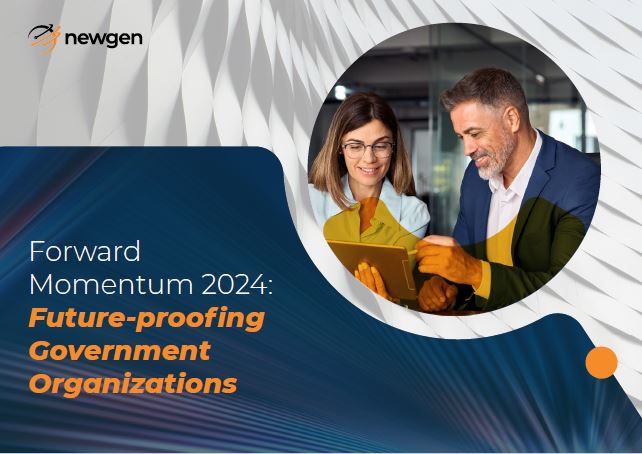Building Simpler, Quicker, Smarter Governments
Governments across the world are embracing transformation at an unprecedented scale. The focus has shifted from basic digitization to future-ready governance — where automation, cloud, and AI drive faster decision-making, efficient operations, and citizen-first experiences.
In 2024, government leaders are prioritizing modernization strategies that enhance back-end efficiency, citizen engagement, and employee productivity, all while maintaining transparency and compliance.
This whitepaper captures the five key technology imperatives shaping modern governance — from cloud-led modernization to AI-driven decision-making — and how these trends can help governments deliver faster, smarter, and more connected services.
1. Cloud-based Legacy Modernization
Legacy systems have long been the Achilles’ heel of public administration. Outdated architectures limit scalability, delay innovation, and make it difficult to deliver personalized citizen services.
Governments are now transitioning toward cloud-native architectures to modernize critical functions — from citizen portals to records management — and ensure resilience, scalability, and cost-efficiency.
Key Benefits
- Scalability and Flexibility: Cloud-based systems scale seamlessly as user demand grows.
- Security and Data Sovereignty: Specialized cloud solutions protect sensitive citizen data.
- Agility Through Microservices: Modular architectures simplify updates and integrations.
- DevOps-Driven Efficiency: Continuous integration and deployment ensure faster delivery cycles.
By adopting whole-of-government (WoG) frameworks and leveraging sovereign cloud solutions, governments can standardize processes while maintaining compliance and control.
2. Hyperautomation with Intelligent Decision-Making
Hyperautomation is transforming how governments operate by integrating AI, ML, RPA, and case management into a unified ecosystem. This convergence allows agencies to automate repetitive workflows, extract insights, and make data-driven decisions in real time.
Core Advantages
- Low-Code Agility: Rapidly deploy citizen-facing applications using low-code automation platforms.
- Predictive Governance: Leverage AI for forecasting and data-backed policymaking.
- Smart Data Utilization: Employ AI/ML for intelligent document and content management.
According to Gartner, by 2026, 60% of government organizations will prioritize process automation — up from 35% in 2022. The trend is clear: automation is no longer optional; it’s essential for responsive, efficient governance.
3. Hyperacceleration with Generative AI
If hyperautomation laid the foundation for digital governance, Generative AI (GenAI) is the accelerator propelling it forward.
GenAI helps governments enhance efficiency by creating synthetic data, generating content, and powering conversational interfaces for citizens. With tools like NewgenONE Marvin, agencies can use GenAI for:
- Citizen App Development: Enable non-technical teams to build adaptive apps using natural language.
- Policy and Case Analysis: Use NLP for summarization and faster decision-making.
- Multilingual Communication: Offer tailored, multilingual engagement to serve diverse populations.
- Real-time Insights: Extract intelligence for proactive governance, law enforcement, and policy refinement.
GenAI unlocks data democratization — empowering every department, not just IT, to innovate and deliver smarter citizen services.
4. Connected Workforce through a Digital Workplace
A connected digital workplace is the backbone of efficient public service delivery. It enables real-time collaboration, transparency, and secure information sharing across departments — all while minimizing reliance on paper.
Key Capabilities
- Real-Time Collaboration: Facilitate document sharing and version control across departments.
- Digital Approvals: Use e-signatures for faster decision cycles.
- End-to-End Content Management: Manage digital documents from creation to archival.
- Secure Access: Provide remote and anytime access with robust authentication and governance controls.
A modern digital workplace empowers government employees to collaborate seamlessly, process citizen requests faster, and ensure continuity of service — even in distributed or hybrid work environments.
5. Total Experience (TX) — Citizen and Employee Experience Unified
Governments are realizing that citizen experience (CX) and employee experience (EX) are interconnected. A seamless Total Experience (TX) approach integrates CX, EX, UX, and MX (multi-experience) to create intuitive and consistent engagement across all platforms.
Benefits of TX-led Governance
- Personalized Interfaces: Enable personalized access to services and applications.
- Omnichannel Reach: Extend services across web, mobile, and social platforms.
- Experience Monitoring: Track satisfaction metrics and continuously improve citizen journeys.
- Governance and Integration: Ensure data governance even across Microsoft and cloud ecosystems.
By 2026, TX-led government models are expected to reduce process ambiguity by 90% and boost satisfaction levels for both citizens and employees by 50%.
How Newgen Empowers Digital Governments?
NewgenONE, the unified low-code digital transformation platform, helps government organizations modernize operations, enhance collaboration, and deliver citizen-centric services faster.
Newgen’s Key Solutions for Public Sector:
- Citizen Service Management: Streamline citizen-facing workflows and requests.
- Dynamic Case Management: Manage complex, multi-stakeholder government cases efficiently.
- Citizen Communication Management: Deliver contextual, omnichannel communication.
- Digital Workplace Management: Enable collaboration and document governance.
- Electronic Document and Records Management: Digitize and secure all public records for easy access and compliance.
What Governments Gain?
- Cloud-Ready Infrastructure: Flexible deployment on private, public, or hybrid cloud.
- Seamless G2G, G2C, and G2B Interaction: Improve coordination across agencies, citizens, and businesses.
- Compliance Assurance: Ensure adherence to national data sovereignty and regulatory mandates.
- Accelerated Service Delivery: Deploy services faster with low-code automation.
The Road Ahead: Reinventing Governance for the Digital Era
Governments today must evolve from reactive administration to proactive service orchestration. Future-ready organizations will be defined by their ability to integrate automation, AI, and human empathy — balancing efficiency with trust.
By adopting a unified, AI-powered digital platform like NewgenONE, governments can transform complexity into simplicity, silos into collaboration, and processes into impact.
Shape the Future of Digital Governance
Build an agile, transparent, and citizen-first government powered by intelligence and innovation.

